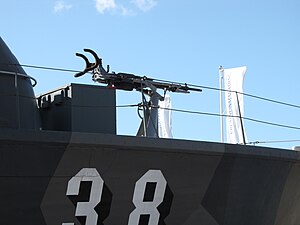Madsen 20 mm anti-aircraft cannon
| Madsen 20 mm cannon | |
|---|---|

Madsen 20 mm cannon
|
|
| Type | |
| Place of origin | Denmark |
| Service history | |
| Used by |
Denmark Finland Ireland Germany Hungary |
| Wars |
World War II Winter War Continuation War Chinese Civil War |
| Specifications | |
| Weight | 55 kilograms (121 lb) |
| Length | 2,500 millimetres (98 in) |
| Barrel length | 1,200 millimetres (47 in) |
|
|
|
| Cartridge | 20 x 120 mm |
| Caliber | 20 mm |
| Rate of fire | 350 rounds per minute |
| Muzzle velocity | 790 metres per second (2,592 ft/s) |
| Effective firing range | 500 metres (1,640 ft) |
| Maximum firing range | 1,800 metres (5,906 ft) |
| Feed system | Drum magazine |
| 20x120 mm Madsen | |
|---|---|
| Type | |
| Place of origin | Denmark |
| Production history | |
| Manufacturer | Kynoch |
| Specifications | |
| Rim diameter | 28.9mm |
The 20 mm AA Machine Cannon M/38 was produced by the Danish company Dansk Industri Syndikat (Danish Industry Syndicate) - DISA - in Herlev near Copenhagen and was used by the military of Denmark in different types of mounting. This cannon was originally constructed by Colonel V. H. O. Madsen and was therefore widely known as the 20 mm Madsen Cannon. A version with a necked-out 23 mm round was also produced, generally known as the 23 mm Madsen.
The mountings were also produced by DISA in the following types:
There were also a number of locally designed mounts.
This type of machine cannon was a very well functioning weapon, which was exported by DISA to several countries.
The 20 mm machine cannons of the Danish Army were responsible for knocking out eleven armoured cars and two Panzer I's during the German invasion before the order to surrender came through.
Madsen cannon at Nuoli gunboat
...
Wikipedia

